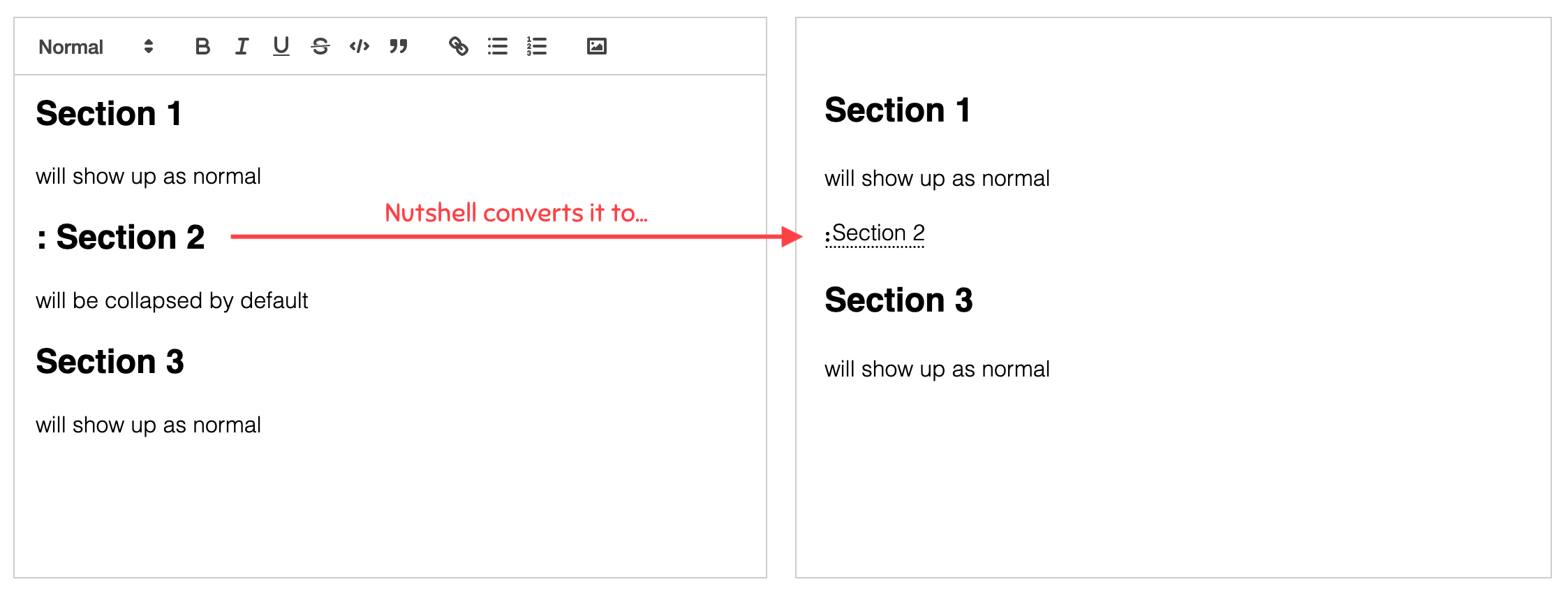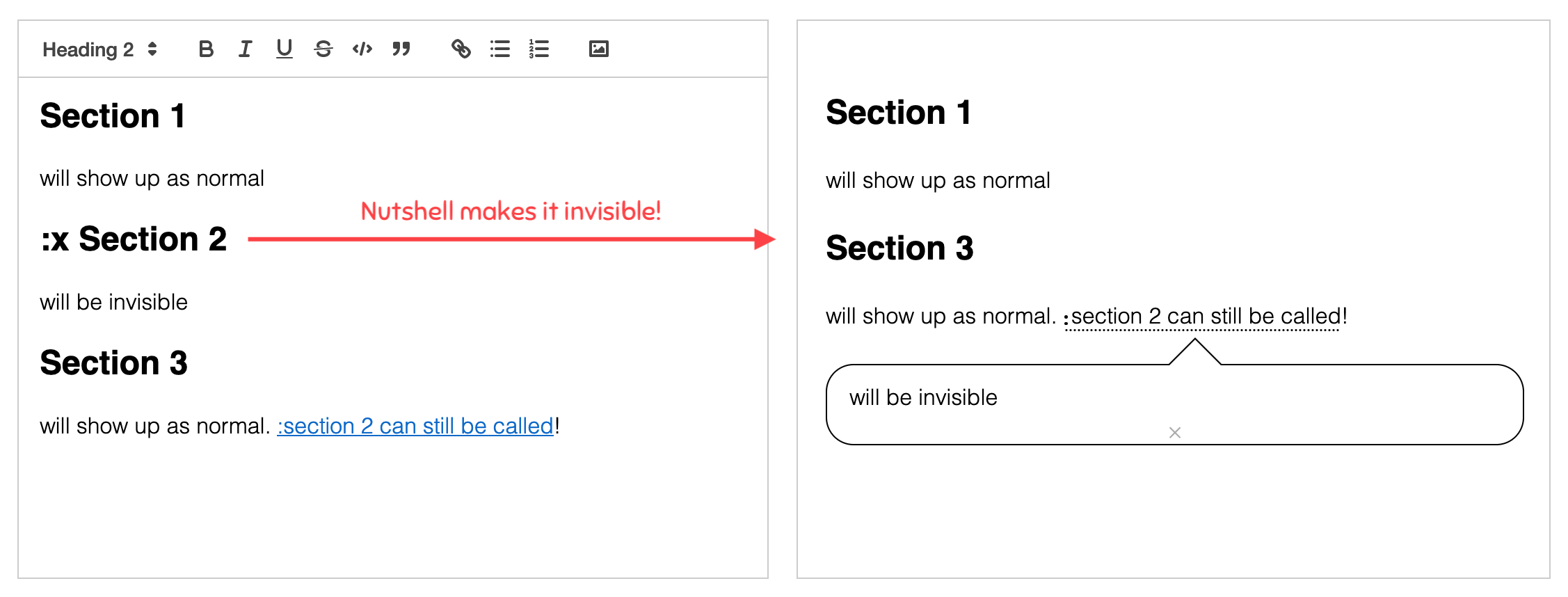Nutshell uses the open-source libraries DOMPurify & Marked. Other than that, all my original content in this repo – code, art & words – are dedicated to the public domain under the Creative Commons Zero waiver.
Readme's Table of Contents:
- There will be no version 2.0.0 (Why Nutshell is minimalist, contributions I accept, possible future tweaks)
- Advanced features & options (Documentation)
“Running a successful open source project is just Good Will Hunting in reverse, where you start out as a respected genius and end up being a janitor who gets into fights.”
Nutshell is open-source, but this is not a "I will take requests & maintain this for the rest of my pathetic life" kind of project. I am pre-committing, right here, to keeping Nutshell minimalist, and only making minor tweaks. There will be no Version 2.0.0 of Nutshell.
That said, I'm accepting two kinds of Pull Requests! 1) Bug fixes, and 2) Translations.
Bug fixes are self-explanatory. Translations are slightly harder.
(Translations already done: French, Esperanto, Dutch, German, Polish, Spanish, Chinese, Hebrew, Turkish, Korean, Russian, Hindi)
In the nutshell.js file, there's a JSON object containing all of Nutshell's English text:
Nutshell.language = {
en: {
// Button text
closeAllNutshells: `close all nutshells`,
// Nutshell errors...
notFoundError: `Uh oh, the page was not found! Double check the link:`,
wikiError: `Uh oh, Wikipedia's not loading, or the link is broken. Please double check:`,
[and so on...]
To help translate Nutshell:
- Copy the "en" object
- Add a new object to
Nutshell.languagewith the 2-letter code for your target language - Translate everything (~150 words) in backtick-quotes (but leave alone the stuff inside
[square brackets]or<angular brackets>!!!) - Send a Pull Request! 🎉
- Give me two weeks to slog through my Sisyphean inbox & finally merge it.
Note: I'm only accepting translations for the Nutshell library, not the demo website.
I'm also not accepting Pull Requests for new features, but feel free to suggest some in the Issues tab, and emoji-upvote (👍) others' suggestions! This will not determine what I make, I'm just curious what y'all want. I am pre-committing: I will only implement minor features *I* personally want.
(If there's a feature you want but I don't, make a fork! Then post your fork in the corresponding Issue, so everyone who also wants that feature can use it, too.)
If you're curious, here's some minor features I maybe MAYBE might add:
- In-built support for:
- Wiktionary
- Vimeo
- LaTeX?? (though, this may be bloat... maybe math blogs oughta install LaTeX-rendering separately.)
- Direct image links (if URL ends in .png, .jpeg, etc, embed that image)
- Embed specific Wikipedia sections, not just the intro paragraph
- Allow "before" and "after" texts for Wiki/YouTube
- Can write full content of a very short Nutshell right in the link. (good for "hint systems")
- A general "plug-in" system so that 1) I don't have a giant if-elseif-elseif statement for handling Wikipedia/YouTube/Vimeo/Wiktionary/Images/etc, and 2) other folks can write their own plug-ins.
- Allowing very limited styling of content in Nutshells. (the problem is to avoid cross-site vandalism that spills outside of the bubble. So, maybe only
background,color,font-size, andfloat?) - An easy tool to make Nutshell links with advanced features, rather than making you go through the documentation & test it in the Try Nutshell demo
- [I DO NOT LIKE THIS IDEA, BUT AM LISTING IT COZ IT'LL BE REQUESTED A LOT]: Configuration option to show bubbles on hover, hide on mouse-out? (May suck for long, recursive nutshells. And mouse-out seems very fragile – move cursor 1px and whoops 3 layers of explanation vanish – plus, won't work on mobile anyway...)
- Put this on npm? For "serious developer" points.
After including Nutshell (e.g. where you put <script src="nutshell.js"><script>), you can optionally configure Nutshell by immediately calling Nutshell.setOptions afterwards, like so:
<script>
Nutshell.setOptions({
startOnLoad: true, // Start Nutshell on load? (default: true)
lang: 'en', // Language (default: 'en', which is English)
dontEmbedHeadings: false, // If 'true', removes the "embed this as a nutshell" option on headings
});
</script>
There are currently 3 options:
startOnLoad (default: true). Set this to false if you don't want Nutshell to immediately run on page load. (e.g. if your article is asynchronously loaded). Later, to actually start Nutshell, call:
Nutshell.start();
By default, Nutshell tries to convert the whole page. To limit Nutshell to converting just a container/element, call:
Nutshell.start(element);
lang (default: 'en'). If Nutshell supports your language, you can make Nutshell speak it by setting lang to your language's two-letter code. (If you're comfortable with programming/Github, see how you can help translate Nutshell)
dontEmbedHeadings (default: false).
When false (by default), it puts an "embed this" button next to all headings on your page, like so:
When set to true, that button does not show up.
Want to change Nutshell's style? Just put CSS after the Nutshell script! To see the classes Nutshell uses (all prepended .nutshell-*), look at Nutshell.defaultStyle in nutshell.js.
For example, this turns the pretty dotted-lines under expandables (the default) into big ugly marker-lines:
<script src="nutshell.js"></script>
<style>
.nutshell-expandable{
border-bottom: solid 10px;
}
</style>
For security reasons, Nutshell can't allow everything to be embedded. But Nutshell does allow: iframes (for interactive content & fun stuff), img, audio, and video.
iframe: Scripts will be allowed, but it cannot access the top page (duh) or call alert() or stuff.
img: Images! The big thing to mention is there's a hack for making images float left/right (like in Wiki articles): add the attribute data-float="left" or data-float="right" to the <img/>. (Direct inline styling is not currently allowed, for security/vandalism reasons. Don't want someone adding position:fixed; z-index:9999; background:url(goatse.jpeg);...)
audio and video: just use as per normal.
What if you want write a section for a Nutshell bubble, but don't want the section to appear by itself, without being manually clicked & expanded? (e.g. for hint systems)
If you put a : at the start of a heading, that whole section will be collapsed into an expandable link when Nutshell starts:
If you put :x at the start of a heading, that whole section will be invisible. (But you can still include it elsewhere!)
Remember, you can test all of these in the Try Nutshell demo! The below examples are written in Markdown for convenience, but will work with rich text & raw HTML too.
Section from the same page: # followed by the text of the section's heading – capitalization, spaces, and punctuation don't matter.
[:dont forget the colon](#SectionHeading)
Section from different page: URL, then # and heading:
[:unsolicited advice](https://ncase.me/faq/#GoodMentalHealth)
Entire article from a page: URL, without # and heading.
[:a whole story](https://blog.ncase.me/parable-of-the-hill-climber/)
Drop the last X paragraphs from a Section: For example, if the original article has a few paragraphs segueing to the next section (which you're not including), you can drop them by adding &cut=[integer] to the end of the link, and it'll drop [integer] number of paragraphs from the end.
[:drop the 2-paragraph segue](url#Heading&cut=2)
Add content before/after an embedded Section: If you want to give context to a section. And yes, you can add recursive nutshells in there! e.g. put some "prerequisite knowledge Nutshells" before the embedded snippet, and some commentary tying it to your main article after the embedded snippet.
To do this, use &before=[content] and/or &after=[content] to the end of your link. The content can be written as text or Markdown. ANNOYING NOTE: You have to run encodeURIComponent on your content before putting it in the link, e.g. [:nutshell](#Nutshell) must become %5B%3Anutshell%5D(%23Nutshell). Use this encoding tool.
Example:
[:controversial](url#Heading&before=RETWEETS%20ARE%20NOT%20ENDORSEMENTS&after=AGAIN,%20I%20DO NOT%20NECESSARILY%20ENDORSE%20THIS)
Example with recursive nutshell in 'before': (note that it's gone through encodeURIComponent)
[:quantum computing](url#Heading&before=First%20you%20need%20to%20know%20about%20%5B%3Aquantum%20mechanics%5D(%23qm))
... I oughta make an easier tool for this, huh.
Section using text-search, not heading: The snippet you want to embed isn't under a convenient heading? You can also get snippets by text-search!
#start=[text] – Gets FIRST paragraph containing that text (ignoring capitalization/spaces/punctuation)
#start=[text]&length=[integer] – Same, but also gets the specified number of paragraphs afterwards (including the first paragraph).
#start=[start-text]&end=[end-text] – Same, but also gets all paragraphs up until the first paragraph containing [end-text]. (again, ignoring capitalization/spaces/punctuation)
Note [text] might need encodeURIComponent, especially if it has punctuation. But Nutshell matches text ignoring punctuation/spaces, so you can just drop them all.
Example: From my blog post on learning-through-multimedia, getting the content between "I make games" and "keep it invisible".
[:Expertise Reversal](https://blog.ncase.me/curse-of-the-chocolate-covered-broccoli-or-emotion-in-learning/#start=imakegames&end=keepitinvisible)
k that's all I have for now, thx bye.
💖 My website · 💸 My Patreon




